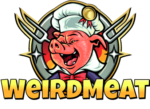Rocky Mountain Oysters are a culinary delicacy that is popular in the Western United States. They are a type of bull testicle that is breaded and deep-fried.
The gonads of these testicles taste quite gamey and meaty, with a hint of venison and chicken flavor. They are a tasty snack that can be served with various dips or sauces.
Overview of eating Rocky Mountain Oysters
If you’re looking to add some exotic flavor to your next meal, you may want to consider Rocky Mountain Oysters. Although they don’t look like oysters, they are actually deep-fried bull testicles.
These testicles are a staple of the Western cowboy culture, often called prairie oysters, calf fries, and cowboy caviar. They’re also served as a delicacy in restaurants and festivals across the country.
They are a popular snack among cattle ranchers in the US and Canada, and they’re a common dish in places like Spain and Mexico. They’re also believed to be a good source of nutrients and are considered an aphrodisiac in many cultures.
Culinary uses
Rocky Mountain Oysters are calf, bull and bison testicles that have been sliced, dredged in a flour or cornmeal mix, and deep-fried. They are often served as an appetizer, but can also be eaten as a main dish.
The food is most commonly found at festivals, among ranching families or at special eating establishments and bars that have a Western theme. It is also available at Coors Field during Colorado Rockies games.
While they are not as popular as in other parts of the country, Rocky Mountain oysters are still a favorite of cowboys and cattle ranchers. They’re a healthy addition to a meat-heavy diet and have been deemed an aphrodisiac by some people.
Availability
Rocky Mountain Oysters are a unique appetizer that are typically deep-fried after being skinned, coated in flour, salt and pepper and sometimes pounded flat. They are a popular delicacy among Western ranchers and Canadians.
They can be found at many restaurants across the country. They are often paired with ketchup, mayonnaise or hot sauce in America and served with demi-glace in Canada.
They have a texture similar to calamari, and their light gamey flavor is halfway between chicken and venison. They are a staple of festivals and kitschy restaurant specials around the country.
Market trends
Despite the fact that Rocky Mountain Oysters are not oysters from the sea, they are widely consumed in the Western United States. Often served as a prank or as a delicacy, they can be found in cowboy restaurants, at small festivals and even at some public venues such as Coors Field, where they’re frequently served during Colorado Rockies baseball games.
Known as prairie oysters, buffalo calf fries and huevos de toro, these wild west delicacies are made from testicles of buffalo, beef, lamb, turkey and goat. They are typically served fried with a spicy dip such as cocktail sauce, duk (apricot and horseradish) sauce or spicy aioli.
Health benefits
Rocky Mountain Oysters are a nutrient-dense food that contains vitamins and minerals. They are a good source of iron and are a great way to boost your metabolism.
They are also a great source of amino acids that help build body tissues and muscles. Additionally, they contain vitamin C, which helps in keeping your body healthy.
They are also known as cowboy caviar, prairie oysters, mountain tenders and calf fries. They are a popular summertime delicacy in many western states and parts of Canada.
Concerns
Oysters are a sustainable food when harvested and eaten by people who follow responsible harvesting practices. They’re low in calories, high in nutrients and a good source of iron, copper, zinc, iodine and magnesium.
They’re also a great way to get your five-percent daily recommended value of vitamin A, B1 (thiamine), B2 (riboflavin), B3 (niacin), B5 (pantothenic acid) and C.
But some sustainability concerns have been raised about this protein-packed, blue-collar food. Rocky Mountain oysters, also called prairie oysters, calf fries and cowboy caviar, are a delicacy that’s deeply rooted in Western lore.

